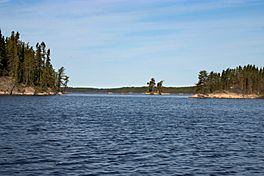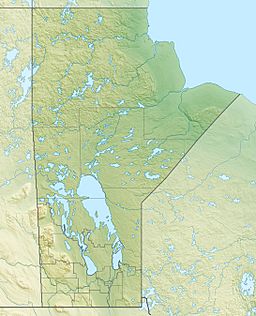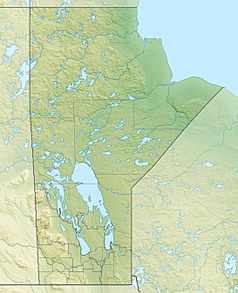Nisto Lake facts for kids
Quick facts for kids Nisto Lake |
|
|---|---|
 |
|
| Location | Manitoba |
| Coordinates | 54°42′1″N 101°30′12″W / 54.70028°N 101.50333°W |
| Lake type | Glacial Lake |
| Primary inflows | Mistik Creek |
| Primary outflows | Mistik Creek |
| Basin countries | Canada |
| Max. length | 3.8 km (2.4 mi) |
| Max. width | 0.9 km (0.56 mi) |
| Surface elevation | 308 m (1,010 ft) |
| Islands | 7 |
Nisto Lake is a cool glacial lake located in the Northern Region of Manitoba, Canada. It's part of the Mistik Creek chain, which eventually flows into Hudson Bay. This means its water drains into a very large area called a drainage basin.
The lake sits in a special area known as the Churchill River Upland. This part of the Midwestern Canadian Shield forests is filled with both mixed deciduous and coniferous trees. Imagine a mix of trees that lose their leaves in fall and those that stay green all year! The land around Nisto Lake has rocky ridges that run side-by-side. You'll also find poorly drained areas called muskeg, which are like spongy wetlands. The lake's shoreline is rocky and uneven because of how glaciers shaped the land long ago. Nisto Lake is also famous for being on the "Mistik Creek Loop," a remote canoe route that's about 80 kilometers long. Adventurers can paddle this route in about four days.
What's in a Name? The Story of Nisto Lake
The name "Nisto" comes from the Cree language. It means "three." This is pretty neat because Nisto Lake is one of fourteen lakes on Mistik Creek that are named in order using Cree numbers. It's like a natural counting system!
Here are the fourteen lakes, listed from south to north, with their Cree names and English meanings:
- Payuk Lake - One (this is where the water flows out)
- Neso Lake - Two
- Nisto Lake - Three
- Nao Lake - Four
- Niyanun Lake - Five
- Nikotwasik Lake - Six
- Tapukok Lake - Seven
- Uyenanao Lake - Eight
- Kakat Lake - Nine
- Mitatut Lake - Ten
- Payukosap Lake - Eleven
- Nesosap Lake - Twelve
- Nistosap Lake - Thirteen
- Naosap Lake - Fourteen (this is where the water starts)



